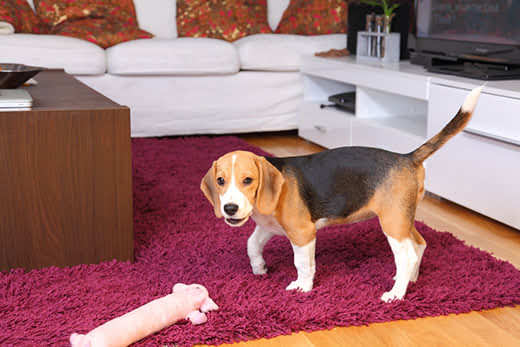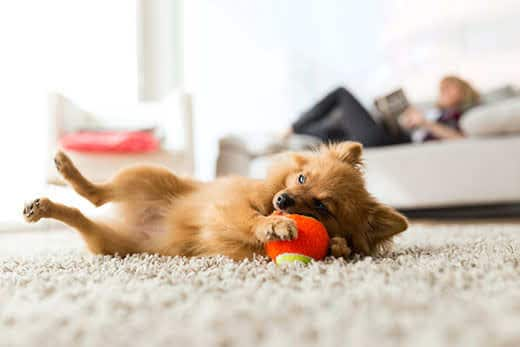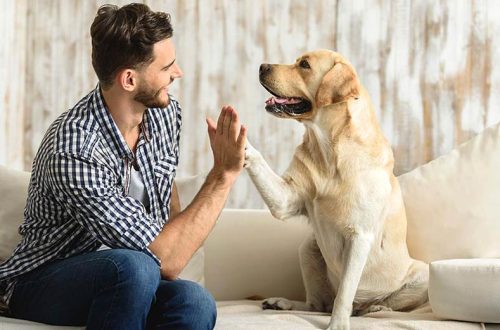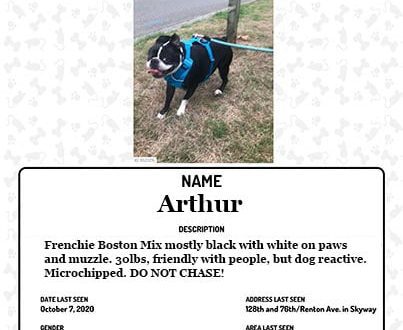
How to prepare an apartment for the arrival of a dog: 3 steps
Living in an apartment is more fun with a dog. But before you get yourself a four-legged friend, you should consider several factors. Which dogs are suitable for an apartment? How to organize a place for a puppy?
Contents
1. Choose a dog suitable for keeping in the available living space
 Before organizing a place for a dog, you need to find out if the chosen breed is suitable for living in an apartment.
Before organizing a place for a dog, you need to find out if the chosen breed is suitable for living in an apartment.
According to CertaPet, in this case size is one of the most significant factors, but it is much more important to consider the dog’s energy level and its tendency to bark.
Regardless of their tiny size, energetic breeds that tend to bark a lot are not suitable for keeping in an apartment. Maybe the owners can train your dog to stop barking constantly and exercises, but it will take a lot of time and effort. It is important to understand whether future owners are ready for such work. If not, it might be better to have a calmer breed that doesn’t require a lot of exercise and doesn’t bark at any strange sound.
Before getting a dog, it’s important to read the rules for keeping pets in an apartment building. Larger breed dogs such as Great Danes и Saint Bernard, as a rule, do well in apartments due to their calm temperament, but the keeping of such dogs may be prohibited by current regulations.
Some apartment owners set limits on the size of dogs that tenants can keep in their apartment. Others ban certain breeds altogether because of their perceived aggressiveness.
- suitable for small spaces;
- bark little;
- well-mannered and polite with strangers;
- able to climb stairs, normally tolerate being in a cramped elevator and on the landing;
- easy to learn to walk on a leash.
When choosing which dog is suitable for the home, you can consult with a cynologist. It will help you choose a pet that will be comfortable in an apartment building.
2. Develop a clear plan and buy everything you need
Having received enough information about the dog, you need to plan for its arrival. Living with a pet may require some adjustments to your routine, so consider the following:
- The age of the dog. How old will the pet be, will it need to be taught to the toilet or will it already be quite independent.
- Preferred place to stay. Will it be possible for a dog to climb furniture and walk freely around the apartment when family members are not at home, or will the pet sit in a cage? At the same time, it is necessary to consider the same points in the context of the pet’s tendency to bark: will the dog bark more if it is in a cage, or, conversely, due to the fact that it begins to move around the apartment?
- Needs for physical activity. Will the owner be able to be at home often enough to walk the pet according to his needs? If not, consider hiring a dog sitter.
The answers to these questions will help determine what your dog needs in a new home. If your pet needs a crate, it’s important to make sure it’s large enough for the new four-legged family member to stand up and turn around.
It is important to remember about the essentials: food, water bowls, leash, harness, dog bed and toys. You should probably also purchase special absorbent mats for puppies, especially if the apartment is carpeted. Additional beds may be needed if the owners do not plan to let the dog on the furniture. If she is allowed to lie anywhere, washable covers and blankets can be purchased to protect the furniture.
3. Prepare the apartment for the appearance of the dog
 After acquiring all the essentials, you should secure the apartment for the dog, recommends Top Dog Tips.
After acquiring all the essentials, you should secure the apartment for the dog, recommends Top Dog Tips.
How to prepare the house for the arrival of a puppy? To do this, you need to get on all fours and go around the apartment, while trying to look around the area through the eyes of a dog. This can identify potential hazards, such as things that can be chewed on, plants that can be toxic to animals, and tight spaces where a small dog or puppy could get stuck.
Dangerous items are best kept out of your pet’s reach or locked in lockers sold in child protection kits. It is necessary to block access to any unsafe places.
Consider switching to household cleaners that are safe for pets, such as using a homemade solution of vinegar and water. If the pet is tall enough to stick its head in the toilet, keep the lid closed.
If the house has a balcony, it is important to make sure that the distance between the balusters of the railing is small enough so that the dog cannot squeeze into it. Otherwise, you need to sheathe the railing with lattice panels or wire mesh, using strong zip ties to secure.
You can make a rearrangement in the apartment, which will free up more space. So the dog can play and stretch comfortably.
If a puppy appears in the house that is still teething, you need to protect the legs of chairs and tables from teeth marks by wrapping them with bubble wrap. In addition, you can use a special bitter-tasting spray bought at the pet store to wean a toothy baby from chewing on furniture.
It is important to think about the plants in the apartment. Make sure they are not toxic to dogs, in case a new pet decides to chew on a few leaves. In addition, it must be taken into account that he can dig the earth in a pot or knock it over, creating a terrible mess.
If the dog is not yet trained, it is important to think about what it can tear. These can be pillows, toilet paper, trash, shoes, socks, etc. You should make sure that until the end of the training, these items will be out of her reach.
Preparing an apartment for a dog depends on several factors, including the temperament and age of the pet, as well as how it fits into the lifestyle of the family. Three basic tips, which are described in the article, will help make the house comfortable for any type of dog.
See also:
- When is the best time to get a dog: choose the season
- Tips for choosing the right dog size
- Ideal pets: dogs that hardly shed or smell
- How to teach your dog not to be afraid to be alone at home





